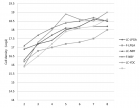Abstract
Research Article
Detection of Clavibacter michiganensis subsp. michiganensis in tomato and chili seeds and farming area of Sinaloa, Mexico
Ruiz Alvarado Cristina*, Soto Ortiz Roberto, Cervantes Diaz Lourdes, Nuñez Ramirez Fidel, Celaya-Michel Hernán and Rueda Puente Edgar O
Published: 08 June, 2018 | Volume 2 - Issue 2 | Pages: 044-054
Phytosanitary inspectors play an important role in diagnosing diseases in foreign plant material. However, some deficiencies have been detected in the detectionc ausing the entrance of many microorganisms. Therefore, it was of great interest to detect the presence of Clavibacter michiganensis subsp. michiganensis (Cmm) in foreign tomato and chili seed in the agricultural area of Sinaloa, Mexico, besides the growth and cell density of Cmm was evaluated in different selective media under continuous illumination and photoperiod. The results indicate that seeed of 35 varieties of tomatoes was collected; while for Chili seed were 18. This study was supported by farmers (225) which represent 79% of all growers and 32 business engaged in the sale of agro-supplies, provided seeds of varieties and hybrids. Those growers are from six areas (Culiacan, El Tamarindo, Navolato, Culiacan, El dorado and Badiraguato). For detection of Cmm in tomato seed, from 35, only four was variability considering Immunochromatography and ELISA techniques; however, considering chemical and physiological test, the result was negative. Similar results were in 18 varietes of chili seed, where eight showed variability to detect Cmm, and negative by chemical and physiological test. According to the growth and cell density of Cmm, the optimal medium was YDC under pH stable and continuous light conditions. It is recommended to consider the fusion of diagnostic techniques in the emission of a result.
Read Full Article HTML DOI: 10.29328/journal.jpsp.1001019 Cite this Article Read Full Article PDF
Keywords:
Bacterial canker; Identification; Diagnosis
References
- Secretaría de Agricultura, Ganadería, Desarrollo Rural, Pesca y Alimentación. Por Estado y Cultivo. Sistema Integral de Información Agroalimentaria y Pesquera. 2017. Ref.: https://goo.gl/Divcbp
- Cierre de ciclo de hortalizas. Confederación de Asociaciones Agrícolas del Estado de Sinaloa. 2017; 3: 10-13.
- Messiaen CM. Enfermedades de las hortalizas. Mundi prensa. Primera ed. México. 2005; 575.
- Nandi M, Macdonald J, Liu P, Weselowski B, Yuan ZC. Clavibacter michiganensis ssp. michiganensis: bacterial canker of tomato, molecular interactions and disease management. Mol Plant Pathol. https://goo.gl/RPcCvm
- Eichenlaub R, Gartemann KH. The Clavibacter michiganensis subspecies: Molecular investigation of Gram-positive bacterial plant pathogens. Annu Rev Phytopathol. 2011; 49: 445-464. Ref.: https://goo.gl/SUjKSH
- Rueda PE. Cuando las enfermedades traspasan las fronteras: México un caso. Congreso Mundial de Trichoderma y Fitopatología. Costa Rica 19 mayo de 2008.
- Rueda PE, Medina D, Alvarado M, García O, Tarazón H, et al. Detección y caracterización de Clavibacter michiganensis subsp. sepedonicus en papaen el estado de Sonora, México. Tropical and Subtropical Agroecosystems. 2009; 10: 13-20.
- López EJA, Huerta-Aldaz N, EstradaDurán GC, Salgado MP, Re Vega E, et al. Effect of salinity on the growth of Isochrysis sp. under static culture conditions. Biotechnology. 2004; 3: 10-15. Ref.: https://goo.gl/tdesed
- Rueda-Puente EO, Tarazón-Herrera MA, García-Hernández JL, Murillo-Amador B, Holguín-Peña RJ, et al. Production of antibodies for bacterial fruit blotch [Acidovorax avenae pv. citrulli (Schaad, Sowell, Goth, Colwell y Webb) Willems, Goor, Thielemans, Gillis, Kersters y De Ley] of watermelon (Citrullus vulgaris Schrad.) in the region Comarca Lagunera, Mexico. Revista Mexicana de Fitopatología. 2006; 24: 129-135. Ref.: https://goo.gl/8Fkn76
- Borboa Flores J, Rueda Puente EO, Acedo Félix E, Ponce JF, Cruz M, et al. Detection of Clavibacter michiganensis subspecies michiganensis in tomato of the state of Sonora, Mexico. Revista Fitotecnia Mexicana. Bravo, Aldunate MyAP 1993. Monografías Hortícolas. CORFO. PUCCH. Santiago. 2009; 136. Ref.: https://goo.gl/G9voEr
- SAS Institute. SAS/STAT user’s guide, Version 6.12 SAS, Institute, Cary, NC, USA. 2001.
- Osuna G, Rodríguez yF. Distrito de Desarrollo Rural Culiacán. ddr004@sin.sagarpa.gob.mx. carret. a Navolato km. 7.5 Bachigualato, Culiacán, Sinaloa. CP. 80140. SAGARPA-Culiacán. 2017; 120.
- 2017. Ref.: https://goo.gl/n9pEZj
- Davis MJ. Taxonomy of plant-pathogenic coryneform bacteria. Annual Review of Phytopathology. 1996; 24: 115-140. : https://goo.gl/VmmhPQ
- Rodríguez MML. Manual para la Identificación de Bacterias Fitopatogenas, 2nd Ed. Universidad Autónoma de Chapingo. 2001; 80-96.
- Rodríguez RR, Rodríguez JMT. Medina SJA. Cultivo moderno del tomate. Segunda Reimpresión. Ed. Mundi-Prensa. Madrid, España. 2001; 15-19. Ref.: https://goo.gl/9Ai1sy
- Schaad NW, Jones JB, Chun W. Laboratory Guide for Identification of Plant Pathogenic bacteria, APS Press, USA. 2001; 1-15.
- Sharabani G, Manulis-Sasson S, Borenstein M, Shulhani R, Lofthouse M, et al. The significance of guttation in the secondary spread of Clavibacter michiganensis subsp. michiganensis in tomato greenhouses. Plant Pathol. 2013; 62: 578-586. Ref.: https://goo.gl/paVzpv
- Sharabani G, Manulis-Sasson S, Chalupowicz L, Borenstein M, Shulhani R, et al. Temperature at the early stages of Clavibacter michiganensis subsp. michiganensis infection affects bacterial canker development and virulence gene expression. Plant Pathol. 2014; 63: 1119-1129. Ref.: https://goo.gl/en56ZH
- Fatmi M, Schaad NW. Survival of Clavibacter michiganensis ssp. michiganensis in infected tomato stems under natural field conditions in California, Ohio and Morocco. Plant Pathol. 2002; 51: 149-154. Ref.: https://goo.gl/LnfBAe
- Lou LX, Walters BH, Liu XL, Li JQ. Quantification of variable cells of Clavibacter michiganensis subsp. michiganensis using a DNA binding dye and a rad-time PCR assay. Plant Pathol. 2007; 135: 1365-3059.
- Borboa Detección e incidencia de Clavibacter michiganensis subespecie michiganensis en Lycopersicon esculentum Mill. en elestado de sonora, México y evaluación del efectobactericida de aceites esenciales. Tesis de Posgrado. Universidad Autónoma de Baja California. Mexicali, Baja California, México. 2009; 80.
- Thyr BD, Samuel MJ, Brown PG. New solanaceous host records for Corynebacterium michiganense. Plant Disease Reporter. 2003; 59: 595-598. Ref.: https://goo.gl/ny258v
- Sen Y, van der Wolf J, Visser RGF, van Heusden S. Bacterial canker of tomato: Current knowledge of detection, management, resistance, and interactions. Plant Dis. 2015; 99: 4-13. https://goo.gl/qBm7Mm
- Mansour MMF, Salama KHA. Cellular basis of salinity tolerance in plants. Environ Exp Bot. 2004; 52: 113-122. Ref.: https://goo.gl/4xAzg5
- Thessen AE, Dortchm Q, Parson ML. Effect of salinity of Pseudo-nitzschia species growth and distribution. J Phycol. 2005; 41: 21-29. Ref.: https://goo.gl/taFiw2
- Rosales NO, Morales JyR. Influencia de la salinidad sobre crecimiento y composición bioquímica de la Clavibacter michiganensis ssp. michiganensis. Ciencias Marinas. 2005; 31: 349-355.
- Arroyo-Pacheco LE, Martínez-Baldenebro F. Producción de biomasa y composición química de dos especies de microalgas a diferentes salinidades. Tesis de Licenciatura. Universidad de Sonora. Hermosillo, Sonora, México. 1994; 78.
- Castro AS, Tavano G. Growth and biochemical composition of the diatome Chaetocerus under different temperature, salinity and dioxide carbon levels. Aquaculture. 2005; 246: 405-412. Ref.: https://goo.gl/EDwUVP
- Tzovenis I, De Pauw N, Sorgeloos P. Optimization of T-ISO biomass production rich in essential fatty acids. Aquaculture. 2005; 203-222.
- Brown MR, Dunstan GA, Norwood SJ. Effects of harvest stage on the biochemical composition of the diatome. J Phycol. 1996; 32: 64-73. Ref.: https://goo.gl/eMVtN1
- Humprey GF. Photosynthetic characteristics under constant illumination and light dark regimes. Journal of Experimental Marine Biology and Ecology. 1979; 40: 63-70. Ref.: https://goo.gl/nEE4nL
- Gitaitsis RD, Sasser MJ, Beaver RW, McInnes TB, Stall RE. Pectolytic Xanthomonads in mixed infections with Pseudomonas syringae pv. syringae, P. syringae pv. tomato, and Xanthomonas campestris pv. vesicatoria in tomato and pepper transplants. Phytopathology. 1987; 77: 6ll-615. Ref.: https://goo.gl/VVfN1E
- López EJA, Huerta-Aldaz N, EstradaDurán GC, Salgado MP, Re Vega E, et al. Effect of salinity on the growth of Isochrysis sp. under static culture conditions. Biotechnology. 2004; 3: 10-15. Ref.: https://goo.gl/tdesed
- Velázquez-Alcaraz TJ, Partida-Ruvalcaba L, Acosta-Villegas B, Ayala-Tafoya F. Producción de plantas de tomate y chile aplicando paclobutrazol al follaje. Universidad y Ciencia. 2008; 24: 21-28. Ref.: https://goo.gl/SmQAMf
Figures:

Figure 1
Similar Articles
-
Isolation and biochemical characterization of Plant Growth Promoting (PGP) bacteria colonizing the rhizosphere of Tef crop during the seedling stageZerihun Tsegaye*,Birhanu Gizaw,Genene Tefera,Adey Feleke,Solomon Chaniyalew,Tesfaye Alemu,Fasil Assefa . Isolation and biochemical characterization of Plant Growth Promoting (PGP) bacteria colonizing the rhizosphere of Tef crop during the seedling stage. . 2019 doi: 10.29328/journal.jpsp.1001027; 3: 013-027
-
Three modern serological methods to detect plant virusesMahmoud Hamdy Abd El-Aziz*. Three modern serological methods to detect plant viruses. . 2019 doi: 10.29328/journal.jpsp.1001039; 3: 101-106
-
Role of pollen morphology in taxonomy and detection of adulterations in crud drugsKshirsagar Sanjay Ragho*. Role of pollen morphology in taxonomy and detection of adulterations in crud drugs. . 2020 doi: 10.29328/journal.jpsp.1001046; 4: 024-027
-
Natural infection of squash fruits (Cucurbita pepo) by Zucchini Yellow Mosaic potyvirus (ZYMV) in Alexandria governorateMahmoud Hamdy Abd El-Aziz*. Natural infection of squash fruits (Cucurbita pepo) by Zucchini Yellow Mosaic potyvirus (ZYMV) in Alexandria governorate. . 2020 doi: 10.29328/journal.jpsp.1001047; 4: 028-032
-
Pathogen identification and control of sooty spot caused by Cladosporium ramotenellum, appearing on fresh easy peeler mandarins from PerúCelia Murciano*,Benito Orihuel-Iranzo,Jeniffer J Oliver-Chirito. Pathogen identification and control of sooty spot caused by Cladosporium ramotenellum, appearing on fresh easy peeler mandarins from Perú. . 2021 doi: 10.29328/journal.jpsp.1001059; 5: 044-052
-
Collection, isolation and characterization of Sclerotinia sclerotiorum, an emerging fungal pathogen causing white mold diseaseMd. Iqbal Faruk*,MME Rahman. Collection, isolation and characterization of Sclerotinia sclerotiorum, an emerging fungal pathogen causing white mold disease. . 2022 doi: 10.29328/journal.jpsp.1001073; 6: 043-051
-
Exploring the Complexity of Protein Structure Determination Through X-ray DiffractionSarah Otun*, Ikechukwu Achilonu. Exploring the Complexity of Protein Structure Determination Through X-ray Diffraction. . 2023 doi: 10.29328/journal.jpsp.1001117; 7: 124-132
Recently Viewed
-
Clinical Significance of Anterograde Angiography for Preoperative Evaluation in Patients with Varicose VeinsDong Liu#,Yi Liu#,Junchen Li#,Tianqing Yao,Yincheng Ran,Ke Tian,Haonan Zhou,Lei Zhou,Zhumin Cao*. Clinical Significance of Anterograde Angiography for Preoperative Evaluation in Patients with Varicose Veins. J Radiol Oncol. 2025: doi: 10.29328/journal.jro.1001073; 9: 001-006
-
eactive Oxygen Species Production from Hydroxamic Acid and their Iron (III) Complexes against Staphylococcus aureus and Escherichia coliIbrahima Sory Sow*, Naïma El Manssouri, Dong Yang. eactive Oxygen Species Production from Hydroxamic Acid and their Iron (III) Complexes against Staphylococcus aureus and Escherichia coli. J Clin Intensive Care Med. 2024: doi: 10.29328/journal.jcicm.1001048; 9: 017-020
-
Avermectins: The promising solution to control plant parasitic nematodesMohamed S Khalil*,Dalia M Darwesh. Avermectins: The promising solution to control plant parasitic nematodes. J Plant Sci Phytopathol. 2019: doi: 10.29328/journal.jpsp.1001036; 3: 081-085
-
Crime Scene Examination of Murder CaseSubhash Chandra*,Pradeep KR,Jitendra P Kait,SK Gupta,Deepa Verma. Crime Scene Examination of Murder Case. J Forensic Sci Res. 2024: doi: 10.29328/journal.jfsr.1001071; 8: 108-110
-
Determination of the in vivo activity of leaves extract of Zanthoxylum Chiloperone var. Angustifolium (Tembetary hú) orally and intralesionally administered to BALB/c mice experimentally infected with LeishmaniaElva Serna*,Marisel Maldonado,Nilsa González. Determination of the in vivo activity of leaves extract of Zanthoxylum Chiloperone var. Angustifolium (Tembetary hú) orally and intralesionally administered to BALB/c mice experimentally infected with Leishmania. Arch Cancer Sci Ther. 2022: doi: 10.29328/journal.acst.1001032; 6: 038-043
Most Viewed
-
Evaluation of Biostimulants Based on Recovered Protein Hydrolysates from Animal By-products as Plant Growth EnhancersH Pérez-Aguilar*, M Lacruz-Asaro, F Arán-Ais. Evaluation of Biostimulants Based on Recovered Protein Hydrolysates from Animal By-products as Plant Growth Enhancers. J Plant Sci Phytopathol. 2023 doi: 10.29328/journal.jpsp.1001104; 7: 042-047
-
Sinonasal Myxoma Extending into the Orbit in a 4-Year Old: A Case PresentationJulian A Purrinos*, Ramzi Younis. Sinonasal Myxoma Extending into the Orbit in a 4-Year Old: A Case Presentation. Arch Case Rep. 2024 doi: 10.29328/journal.acr.1001099; 8: 075-077
-
Feasibility study of magnetic sensing for detecting single-neuron action potentialsDenis Tonini,Kai Wu,Renata Saha,Jian-Ping Wang*. Feasibility study of magnetic sensing for detecting single-neuron action potentials. Ann Biomed Sci Eng. 2022 doi: 10.29328/journal.abse.1001018; 6: 019-029
-
Pediatric Dysgerminoma: Unveiling a Rare Ovarian TumorFaten Limaiem*, Khalil Saffar, Ahmed Halouani. Pediatric Dysgerminoma: Unveiling a Rare Ovarian Tumor. Arch Case Rep. 2024 doi: 10.29328/journal.acr.1001087; 8: 010-013
-
Physical activity can change the physiological and psychological circumstances during COVID-19 pandemic: A narrative reviewKhashayar Maroufi*. Physical activity can change the physiological and psychological circumstances during COVID-19 pandemic: A narrative review. J Sports Med Ther. 2021 doi: 10.29328/journal.jsmt.1001051; 6: 001-007

HSPI: We're glad you're here. Please click "create a new Query" if you are a new visitor to our website and need further information from us.
If you are already a member of our network and need to keep track of any developments regarding a question you have already submitted, click "take me to my Query."
























































































































































